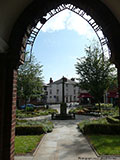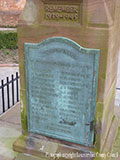Private Alfred Corrall, 41397
- Batt - 5
- Unit - Lincolnshire Regiment
- Section -
- Date of Birth - 1898
- Died - 26/09/1917
- Age - 19
Add to this record?
If you have photographs, documents or information that can contribute to this record, you can upload here
ContributeSource: Michael Doyle Their Name Liveth For Evermore: The Great War Roll of Honour for Leicestershire and Rutland. He was the son of Thomas Corrall, a shoe trade finisher, born 1869 in Leicester and his wife Clara Corrall (nee Spencer, married on the 17th February 1894 in St. Luke’s Church, Leicester), born 1876 in Loughborough, Leicestershire. Alfred was born in the 3rd quarter of 1898 in Leicester, his siblings were, Hephzibah, born 1895, George, born 1896, Clara, born 1897 and Nellie Clara, born 1901, all his siblings were born in Leicester, in March 1901 the family home was at Vernon Road, Leicester. In April 1911 Alfred was a schoolboy and was residing in the family home at 243, Saffron Lane, Leicester, together with his father, a boot and shoe trade worker, his mother and siblings, Hephzibah, a boot and shoe trade machinist, Nellie, a schoolgirl, Thomas, a schoolboy, born 14th December 1902 and Percy, born 16th July 1906, the latter two siblings were both born in Leicester. Alfred also had the following younger siblings, Cyril, born 1st December 1911, Gladys, born 1st September 1913 and Frank, born 21st December 1915, the latter three siblings were all born in Leicester. In 1939 the latter three siblings were all still residing in the family home at 243, Saffron Lane, Leicester. Alfred enlisted into the Leicestershire Regiment, being allotted the service number 25580, he was then transferred to the 13th Training Reserve Battalion and allotted the service number 9062 and was subsequently transferred to the 2/5th Battalion Lincolnshire Regiment, and it was whilst serving with this Battalion that he was recorded as killed in action, date presumed to be the 26th September 1917. His body was never recovered and he is commemorated on the Tyne Cot Memorial, Passchendaele, Belgium. He was awarded the British War and Victory medals.
The War Diary records: 26 Sept-17 – WEST of HILL 37. For account of operations see Appendix attached. The Battalion attacked, gained and held its objectives. The night of 26 – 27 passed quietly and no attempt was made by the enemy to recover the captured ground.
Account of the action by the 2/5th Lincolnshire Regiment on 26th September 1917. (Ref to Sheet 28.N.W. & N.E. and special maps attached.)
25.9.17. The original British front line was as shown on barrage map attached to Brigade orders attached hereto.
The Battalion moved up from the trenches S. of WIELTJE at 11.00pm moving by track 5 in single file, and formed up in the position of assembly with the front along the line D.20.a.0.8. – Z in ZEVENCOTE, with the right resting 50 yards S.E. of DELVA FARM (D.20.a.0.3.) the line extending to 400x. The forming up was carried out on tapes previously laid out, the limits of each platoon being marked out by pegs bearing the number of the platoon. The formation was as shown on diagram attached. The heavy bombardment of the enemy’s position was short, from Zero minus two hours to Zero. The barrage was put down 150x in front of the original front line at Zero, 5.50am. The troops moved in the formation in which they formed up and followed the 2/5th LEICESTERSHIRE REGIMENT who were in front. The 2/4th LINCOLNSHIRE REGIMENT were on our right, and the 2/5th SHERWOOD FORESTERS on our left. The Battalion attacked on a two Company frontage, “B” Company (2nd Lieutenant) H. C. W. CHAMBERS 3rd ESSEX REGIMENT) being on right and “D” Company (Captain G. L. HILL) on the left. “C” Company (Captain C. N. NEWSUM) was in support and “A” Company (2nd Lieutenant W. PARVIN) in reserve and furnishing carrying parties. Only 20 officers took part in the attack the remainder remaining at the Transport lines. The formation shown was maintained until the objectives were reached. The objectives were as stated in the operation order issued attached hereto. “D” Company on the left met with practically no resistance, the concrete block houses at D.14.d.7.6. being non-existent. “D” Company commenced to dig a strong post at D.14.d.7.6. and sent a platoon across to assist “B” Company in the capture of DOCHY FARM D.20.c.2.2. The remainder of the Company commenced consolidation of the position behind the strong post. “B” Company attacking DOCHY FARM as final objective were met by enemy machine gun and rifle fire but worked to the flanks of the bock houses when the garrison surrendered. Some 50 prisoners were captured here. The final consolidation was shown on the map. A Lewis gun post was pushed forward in front of each Company’s position. Dispositions at 8.30am. Strong posts under construction at DOCHY FARM and at D.14.d.7.6. Shell holes connected and deepened in rear of these posts for remainder of assaulting Companies (“B” and “D” Companies). The support Company consolidated a line of shell holes running approximately from D.14.d.5.4. to D.20.c.9.9. The reserve Company was used up for carrying parties and for runners. The enemy’s barrage was fairly heavy but the attack had pressed well on by the time it fell on our old front lines and the places of assembly, and did not cause many casualties. Finally it was directed against the newly taken positions where casualties were rather more. In particular the captured block houses came in for more than usual attention and seem to be places to avoid. The consolidation proceeded during the morning and afternoon. Late in the afternoon the enemy shelling increased very much in intensity and a small number of enemy were seen moving in front of our positions. A few men – of what regiments it is not known – commenced to retire as did the left Brigade of the 3rd Division on our right and a general retirement appeared imminent. Our own barrage fell in front of our positions and the retiring troops were rallied and resumed their positions. The front line posts did not withdraw. The cause of this withdrawal has not been discovered but there was no heavy counter attack nor did any of the enemy attempt to pass through our barrage on this units front. By 8.30pm all original positions were occupied. The men behaved with the greatest gallantry throughout and on several occasions had to be checked from passing through our own barrage to their objectives, especially during the wait behind the 2/5th LEICESTERSHIRE REGIMENT until Zero plus 100 minutes when the Battalion passed through the 5th LEICESTERSHIRE REGIMENT to our own objectives. It was found quite possible to keep up with the barrage which in the later stages moved 100x in 8 minutes. The average distance from the barrage was about 50x. Company commanders maintained the direction of the attack by means of compass bearings and these were very necessary as the country was almost unrecognisable. Our correct objectives were reached and the barrage closely followed the whole time. The formation adopted was quite satisfactory and was maintained the whole way. The line of skirmishers was at times very irregular and difficult to maintain but it was found that the sections in file kept fairly well together and moved well. The lines were not deployed until our objectives were reached. The enemy did not show much fight and the sections of “A” Company attached to “B” and “D” Companies as moppers up did not have much to do. Difficulty was experienced in thinning out the troops on the newly captured positions owing to the short distance between our final objective and the objective of the 2/5th LEICESTERSHIRE REGIMENT behind us. Communication was difficult both forward and to the rear. Telephone lines were laid in triplicate forward but broke down in every case. Situation reports were sent back to Division by pigeon and reached their destination safely. Communication with Brigade was chiefly carried out through relays of runners as the telephones continually broke down. It would appear to be of first importance to have plenty of well trained runners and to establish relay posts at intervals of 100x or less if possible.
Signed J. C. -?-, Captain and Adjutant, 2.5th Lincolnshire Regiment. In the Field 3.10.17.
- Conflict - World War I
- Unit - Lincolnshire Regiment
- Former Unit n.o - 25580 & 9062
- Former Unit - Leicestershire Regiment & 13th Training Reserve Battalion
- Cause of death - KILLED IN ACTION
- Burial Commemoration - Tyne Cot Mem., Zonnebeke, West Vlaanderen, Belgium
- Born - Leicester
- Enlisted - Leicester
- Place of Residence - 243 Saffron Lane, Leicester, Leicestershire, England




